Case Report - Volume 3 - Issue 5
Femoral neck fractures in adults: Epidemiological aspects and evaluation of the results of surgical treatment in the Orthopedics-Traumatology Department of the Ignace Deen University Hospital
Keïta K1; Camara T1*; Madjirabé NH1; Fofana LI1; Youla M1; Sylla FM1; Bah ML1; Lamah L2
1Orthopedics-Traumatology Department of Ignace Deen University Hospital, Conakry.
2Orthopedics-Traumatology Department of Donka University Hospital, Conakry
Received Date : Sep 12, 2023
Accepted Date : Oct 02, 2023
Published Date: Oct 12, 2023
Copyright: © Tafsir Camara 2023
*Corresponding Author : Tafsir Camara, Orthopedics-Traumatology Department of Ignace Deen University Hospital, Conakry.
Email: camaratafsir@gmail.com
DOI: Doi.org/10.55920/2771-019X/1567
Abstract
Introduction: Femoral neck fractures are solutions of bone continuity affecting the region located between the ephalic rim and the supratrochanteric region. The objective of this study is to ensure the management of femoral neck fractures in adults and to evaluate the results of surgical treatment.
Patients and Methods: This was a longitudinal study with a descriptive aim, lasting 3 years (January 2019 to December 2021), including adult patients hospitalized for a femoral neck fracture, treated and evaluated according to the rating by Postel and Merle D'Aubigné.
Results: Femoral neck fractures in adults represented 2% of all hospitalizations. They affect both sexes with a female predominance of 55% and an average age of 63.2 years. Garden type IV femoral neck fractures represented 60% of cases and 90% of patients underwent intermediate arthroplasty. We found 5 cases of postoperative complications including 2 cases of prosthesis dislocation. At last follow-up, the postoperative PMA rating was excellent in 50% of cases.
Conclusion: femoral neck fractures are the prerogative of elderly females. Intermediate hip arthroplasty is a better treatment option to achieve satisfactory functional results.
Keywords: Femoral neck fracture; Adult; Epidemiology; Treatment results.
Introduction
Femoral neck fractures (FNF) or true cervical fractures are defined by their intracapsular location and their anatomical limits, namely the cervico-trochanteric crest and the cervico-cephalic chondro -osseous junction. They most often occur during low-energy domestic trauma in elderly women with osteoporosis [1, 2]. In young adults, true cervical fractures occur after high-energy trauma and often in the context of polytrauma and multiple fractures [3]. The treatment of choice for most femoral neck fractures is operational to allow early mobilization of the patient, reduce the risk of complications and improve functional results [4]. These lesions require diametrically opposed operating techniques, namely reconstructive osteosynthesis based on the potential for locoregional osteogenesis, and arthroplasty taking advantage of traumatic cervicotomy to implant a prosthesis [3]. Thus, the objective of this study was to ensure the management of femoral neck fractures in adults and to evaluate the results of surgical treatment.
Patients and methods
This was a longitudinal study aimed at descriptive ranging from January 2019 to December 2021. We targeted adult patients hospitalized in the department for a fracture of the upper end of the femur. The study population consisted of adult patients hospitalized in the department for a femoral neck fracture. We included in this study adult patients with a femoral neck fracture, treated, followed and evaluated. The data collected concerned frequency, age, sex, circumstances of occurrence, Garden classification [5], type of surgical treatment used, complications and PMA rating (Postel and Merle d'Aubigné) [6] postoperative. All patients underwent a complete clinical examination to determine the mechanism of injury and the circumstances of occurrence. X-rays of the pelvis (face) (Fig. 2A) and the affected hip (profile) (Fig. 2B) were taken for all patients in order to describe the anatomopathological lesions and to type them according to the Garden classification [5].
Table 1: Classification of Garden [5].

The patients were all taken to the operating room under spinal anesthesia combined with the epidural. The Hardinge, Moore and Watson-Jones approaches were the three main approaches used. For young subjects we performed osteosynthesis by screwing (Fig. 3B), by DHS (Dynamic Hip Screw) or by PFN (Proximal Femoral Nail). In elderly subjects, in case of recent fracture or non-union of the neck, we performed intermediate hip arthroplasties (Bipolar Hip Prothesis) (Fig. 3A).
We recorded postoperative complications such as superficial infection managed by series of dressings associated with antibiotic therapy; dislocation of the prosthesis (Fig. 4) requiring bloody reduction; and aseptic reinforced pseudarthrosis of the femoral neck motivating the performance of an intermediate arthroplasty. We also found one case of death.
Functional outcomes were assessed using the PMA rating. It evaluates pain, mobility and walking, each rated from 0 to 6. An x-ray of the pelvis (face) was taken 120th days before the evaluation.
Table 2: Rating of Postel and Merle d'Aubigné [6].

The results obtained were distributed as follows:
- Excellent : if the rating equals 18;
- Very good : if the rating equals 17;
- Good : if the rating is between 15 and 16;
- Fair: if the rating is between 13 and 14;
- Poor: if the rating is between 9 and 12;
- Bad: if the rating < 9.
Results
During the study period, 1891 patients were hospitalized in the department, 40 of whom had a femoral neck fracture, representing a hospital frequency of 2.1%. The average age of the patients was 63.2 years with the extremes of 25 and 98 years. The female gender was the most represented in 55% of cases with a sex ratio of 0.8. Falls from height dominated the etiologies with 75% of cases.
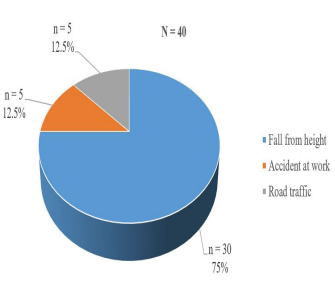
Figure 1: Frequency of femoral neck fractures according to etiologies.
According to Garden's classification, type IV (Fig. 2) was the most represented with 60% of cases, followed by type III in 22.5% of cases.
Table 3: Frequency of femoral neck fractures according to the Garden classification.
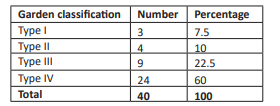
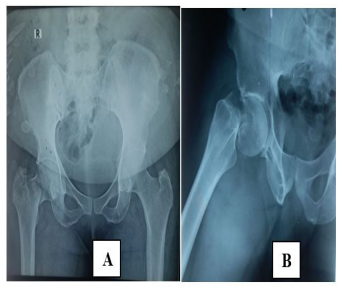
Figure 2: Radiographs: A: Pelvis (front), B: right hip (profile) showing a Garden type IV femoral neck fracture.
Intermediate hip arthroplasty (Fig. 3A) was performed in 36 patients, or 90% of cases. The 4 other patients benefited from conservative treatment including 2 cases of screw fixation (Fig. 3B), 1 case of osteosynthesis by DHS and 1 case of osteosynthesis by PFN.
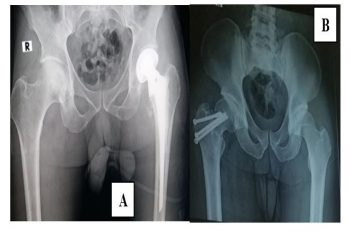
Figure 3: X-ray of the pelvis: A: Cemented BHP, B: Triple screwing.
We found 5 cases of postoperative complications, namely 2 cases of dislocation of the prosthesis (Fig. 4), 1 case of superficial infection, 1 case of aseptic reinforced nonunion and 1 case of death.
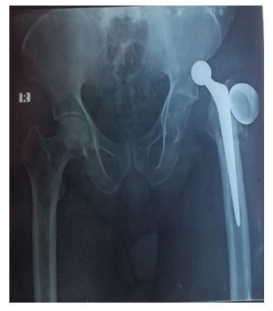
Figure 4: X-ray of the pelvis showing dislocation of the prosthesis.
After a 4-month follow-up, the patients were evaluated according to the PMA rating. The functional results were excellent in 20 cases (50%), good in 10 cases (25%), fair in 8 cases (20%) and poor in 2 cases (5%).
Discussion
Femoral neck fractures accounted for 2.1% of all hospitalizations. Unlike Diaz AR et al. [7] in 2018 in Spain, Liu P et al . [8] in China in 2021, which found respective frequencies of 51.4% and 57% of cases. This difference in frequency would be related to the fact that the Guinean population is largely made up of young people compared to Western countries where the population is aging.
The average age of patients was 63.2 years with a female predominance in 55% of cases. Bel JC et al. [9] in France in 2011 reported an average age of 83.2 ± 9 years and a female predominance of 88.5% of cases. On the other hand, Monka M et al. [10] in 2018 in Congo Brazzaville found a male predominance of 81.8% of cases. Femoral neck fractures are the prerogative of elderly osteoporotic subjects.
Domestic accidents such as falling from a height were the most common etiology in 75% of cases. The finding was the same in the study by Diaz AR et al. [7] where falls represented 80.9% of the causes of femoral neck fractures. In the elderly, muscle weakness, joint damage weight-bearing, balance and coordination disorders, vision disorders can be the cause of falls responsible for low-energy trauma.
Therapeutically, an intermediate arthroplasty was performed in 90% of patients. In the study by Erivan R et al. [11], 68.1% of patients benefited from an intermediate prosthesis. Intermediate arthroplasty proves to be an effective treatment option providing excellent pain relief, early mobilization and a good long-term return to activities in elderly subjects [4].
It appears from this study that dislocation of the prosthesis was the most common postoperative complication. In the literature, the dislocation rate for intermediate prostheses varies between 0 and 20% [12-14].
According to the postoperative PMA rating, we obtained 50% excellent functional results versus 5% poor results Monka M et al. [10] reported 45.4% very good results . Operative management of femoral neck fractures makes it possible to satisfactorily restore the patients' previous autonomy.
Conclusion
Femoral neck fractures represent one of the most common fractures in trauma. They are most often aimed at elderly, osteoporotic, female subjects and generally occur during low-energy trauma. Surgical treatment is the best therapeutic choice to restore a pain-free, stable and functional hip.
References
- Cordey J, Schneider M, Bühler M. The epidemiology of fractures of the proximal femur. Injury. 2000; 31(Suppl 3): 56-61.
- Court-Brown CM, Caesar B. Epidemiology of adult fractures: a review. Injury. 2006; 37(8): 691-7.
- Bonnevialle P. Traitement des fractures récentes du col femoral de l’adulte. Techniques opératoires. EMC-Techniques chirurgicales-Orthopédie-Traumatologie. 2015; 10(4): 1-13.
- Florschutz AV, Langford JR, Haidukewych GJ, Koval KJ. Femoral Neck Fractures: Current Management. J Orthop Trauma. 2015;29(3):121-9.
- Garden RS. Stability and Union in Subcapital Fractures of the Femur. J Bone Joint Surg Br. 1964; 46: 630-47.
- D’Aubigné MR, Postel M. Cotation chiffrée de la fonction de la hanche. Rev Chir Orthop. 1970; 56(5): 481-6.
- Diaz AR, Navas PZ. Risk factors for trochanteric and femoral neck fractures. Rev Esp Cir Ortop Traumatol. 2018; 62 (2):134-41.
- Liu P, Zhang Y, Sun B, Chen H, Dai J, Yan L. Risk factors for femoral neck fracture in elderly population. J Cent South Univ Med Sci. 2021; 46(3): 272-7.
- Bel JC, Fischer LP. Fractures du col femoral non déplacées des sujets très âgés. Traitement fonctionnel ou orthopédique : comparaison n’est pas raison. E-Mémoires de l’Académie Nationale de Chirurgie. 2012; 11(4): 21-6.
- Monka M, Mandavo CM, Bouhelo -Pam K, Ngatse-Oko A, Dakouré PW, Moyikoua A. Results of Screwing Femoral Neck Fractures in Adults at University Hospital of Brazzaville. Open J Orthop. 2018; 8(6): 227-3
- Erivan R, Soleihavoup M, Villatte G, Perez Prietoc D, Descamps S, Boisgard S. Poor results of functional treatment of Garden-1 femoral neck fracture in dependent patients. Orthop. Traumatol Surg Res. 2020;106(4): 601-5.
- Burgers PT, Van Geene AR, Van den Bekerom MP, Van Lieshout EM, Blom B, Aleem IS, et al. Total hip arthroplasty versus hemiarthroplasty for displaced femoral neck fractures in the healthy elderly: a meta-analysis and systematic review of randomized trials. Int Orthop. 2012; 36(8): 1549-60.
- Bensen AS, Jakobsen T, Krarup N. Dual mobility cup reduces dislocation and re-operation when used to treat displaced femoral neck fractures. Int Orthop. 2014; 38(6): 1241-5.
- Svenøy S, Westberg M, Figved W, Valland H, Brun OC, Wangen H, et al. Posterior versus lateral approach for hemiarthroplasty after femoral neck fracture: early complications in a prospective cohort of 583 patients. Injury. 2017; 48(7): 1565–9.

